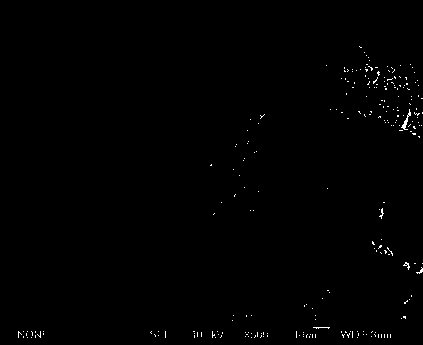Method for regenerating used oil by adopting antibiotic waste mushroom dreg biomass charcoal
A technology of antibiotic waste and biochar, applied in chemical instruments and methods, lubricating compositions, other chemical processes, etc., can solve the problems of high oil absorption rate, increased refining consumption and cost, etc., and achieve the solution of disposal problems and good adsorption performance , the effect of high specific surface area
- Summary
- Abstract
- Description
- Claims
- Application Information
AI Technical Summary
Problems solved by technology
Method used
Image
Examples
Embodiment 1
[0022] 1) Sterilize the waste antibiotic residue at 121°C for 20 minutes to inactivate the mycelium;
[0023] 2) Dehydrate the antibiotic waste slag after the above-mentioned sterilization treatment at 8,000 rpm for 20 minutes in a centrifuge, and then put it into an oven to dry at 105-110°C for 4 hours;
[0024] 3) Carbonize the waste antibiotic residue after the above dehydration treatment at 750°C for 1 hour under the protection of nitrogen, pickle the obtained product with hydrochloric acid with a concentration of 4% by mass percentage, then wash with water until neutral, and dry at 105-110°C for 2 hours , cooled to room temperature, and the waste biochar was prepared. The attached figure is the electron micrograph of the prepared waste biochar. The figure shows that the waste antibiotic residue releases some gas and volatile Substances have formed many large, medium and small pore sizes, which are conducive to the adsorption of pollutants;
[0025] 4) After the waste eng...
Embodiment 2
[0028] 1) Sterilize the waste antibiotic residue at 121°C for 20 minutes to inactivate the mycelium;
[0029] 2) Dry the waste antibiotic residue after the above sterilization treatment in the air, and then dry it at 105-110°C for 4 hours;
[0030] 3) Carbonize the waste antibiotic residue after the above dehydration treatment at 300°C for 1 hour under the protection of nitrogen, activate it with steam at 500°C for 0.5 hour, pickle the obtained product with 10% hydrochloric acid by mass percentage, and then wash it with water to medium Drying at 105-110°C for 2 hours, cooling to room temperature, to obtain bio-activated carbon from waste fungus residue;
[0031] 4) After the waste engine oil is left to stand, it is separated into layers, the water in the lower layer is removed, and then the solids and suspended matter are filtered to obtain the treated waste engine oil;
[0032] 5) Heat the above treated waste engine oil to 60°C, and add waste bioactivated charcoal under cont...
Embodiment 3
[0034] 1) Sterilize the waste antibiotic residue at 121°C for 20 minutes to inactivate the mycelium;
[0035] 2) Dehydrate the antibiotic waste residue after the above sterilization treatment by plate and frame filter press, and then dry it at 105-110°C for 4 hours;
[0036] 3) Add the dehydrated antibiotic waste slag to 40% zinc chloride solution with a liquid-solid ratio of 1:1 (w / w), carbonize at 400°C for 0.5h under nitrogen protection, and then increase Activate at 600°C for 60 minutes, pickle the obtained product with sulfuric acid with a mass percentage concentration of 3%, then wash with water to neutrality, dry at 105-110°C for 2 hours, and cool to room temperature to obtain activated carbon from waste bacteria residue biomass;
[0037] 4) After the waste engine oil is left to stand, it is separated into layers, the water in the lower layer is removed, and then the solids and suspended matter are filtered to obtain the treated waste engine oil;
[0038] 5) Heat the a...
PUM
 Login to View More
Login to View More Abstract
Description
Claims
Application Information
 Login to View More
Login to View More - R&D
- Intellectual Property
- Life Sciences
- Materials
- Tech Scout
- Unparalleled Data Quality
- Higher Quality Content
- 60% Fewer Hallucinations
Browse by: Latest US Patents, China's latest patents, Technical Efficacy Thesaurus, Application Domain, Technology Topic, Popular Technical Reports.
© 2025 PatSnap. All rights reserved.Legal|Privacy policy|Modern Slavery Act Transparency Statement|Sitemap|About US| Contact US: help@patsnap.com

